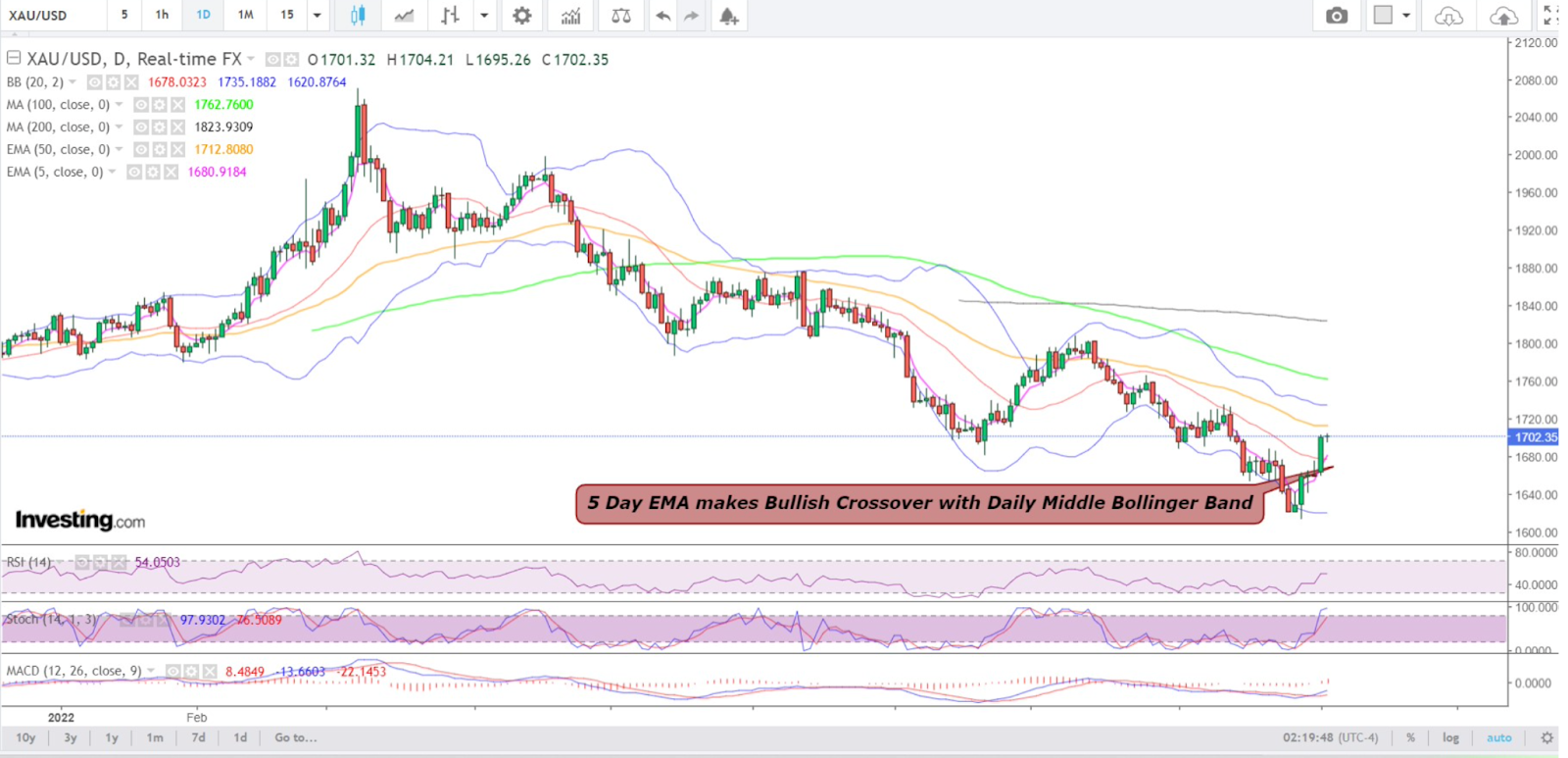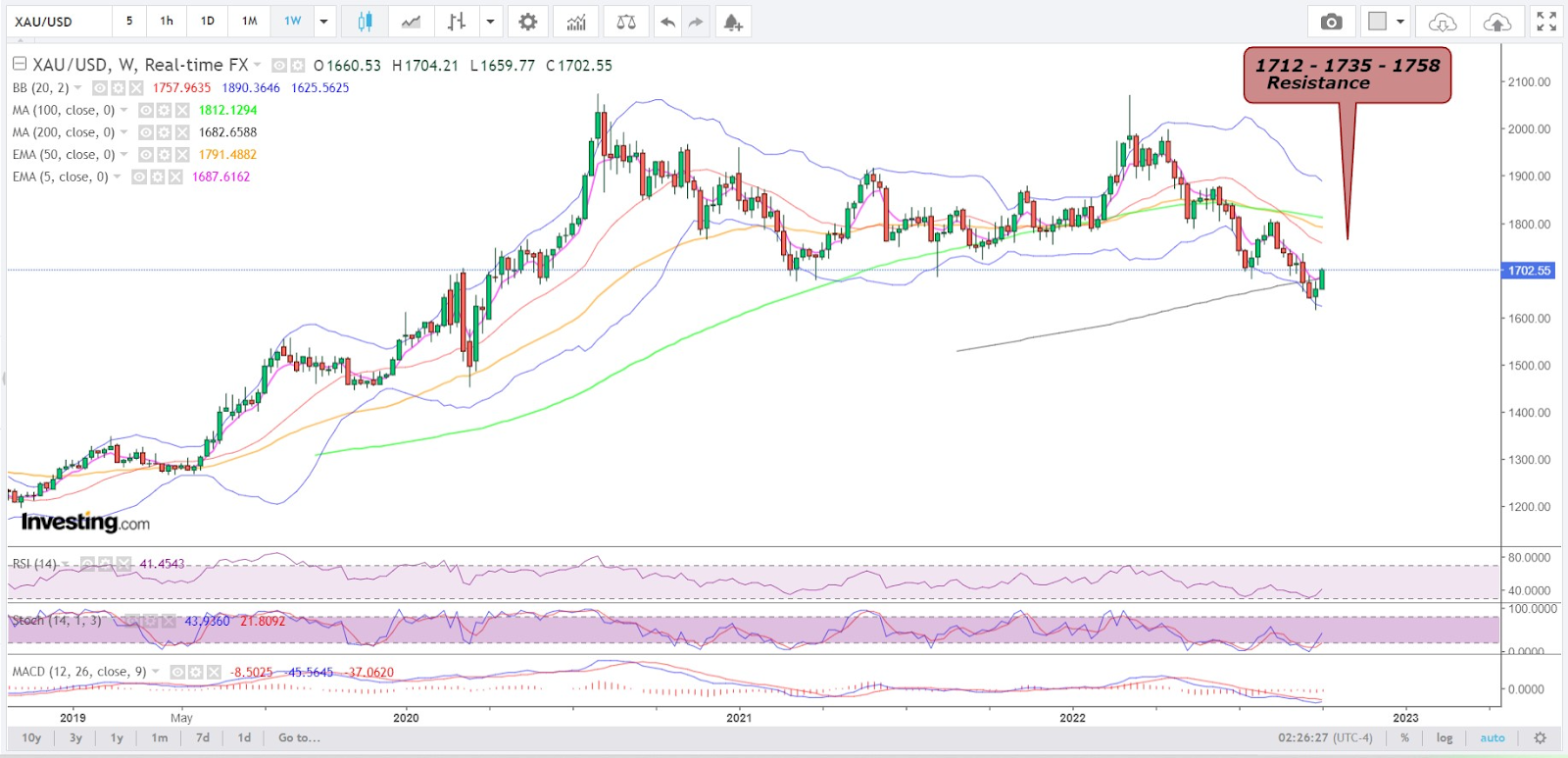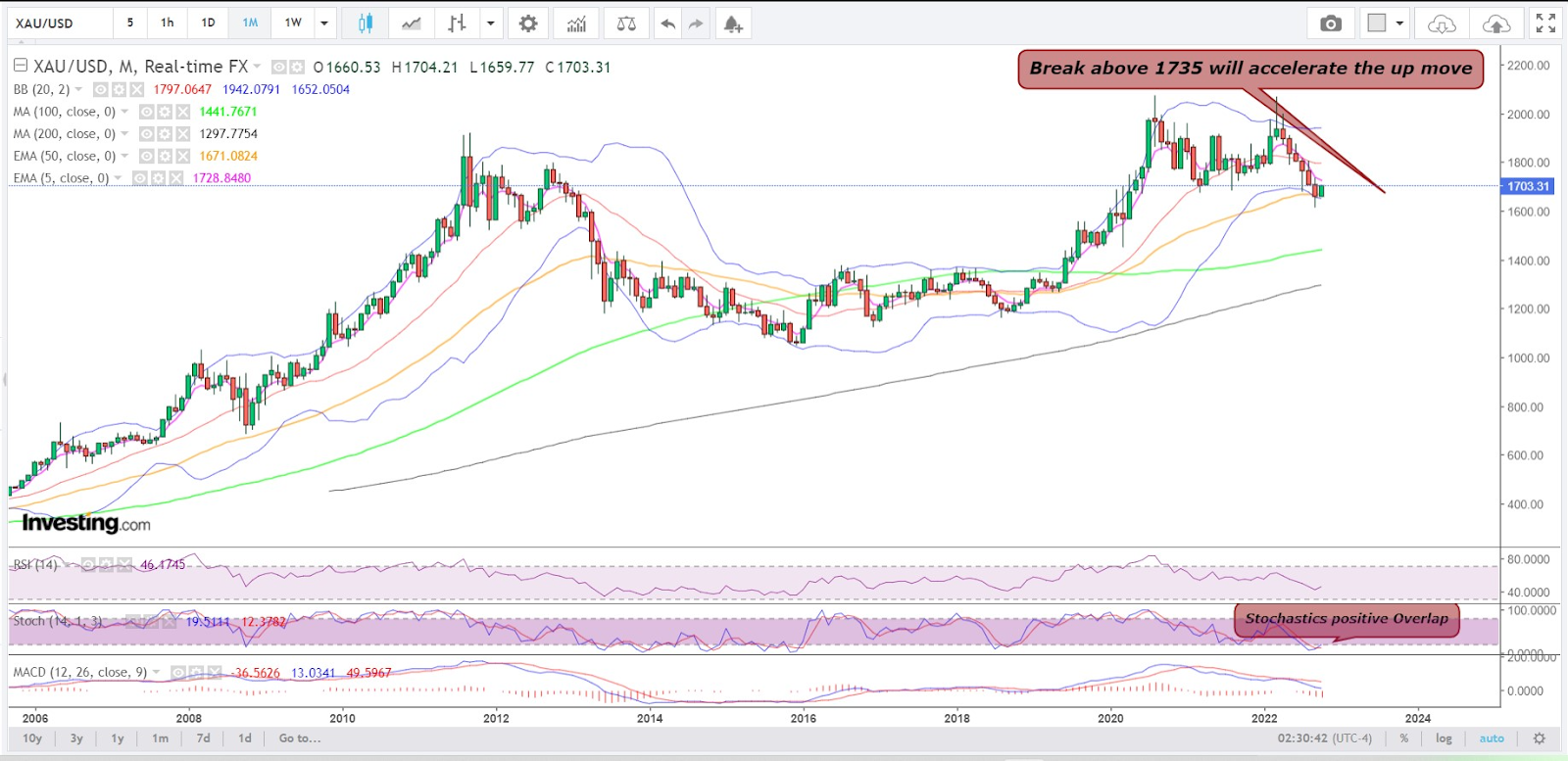- Gold back at $1,700, first time since Sept. 14 after near 2% gain over five days
- Monday’s rally in gold fired by poor US factory activity
- Gold bulls hope US data gets worse throwing Fed off jumbo-sized hikes
In a world where bad news will likely get you good news from the US Federal Reserve, gold bulls are probably hoping things get significantly uncomfortable in the United States—not on the inflation front but on the economy itself—that the central bank will be dissuaded from using jumbo-sized rate hikes to hammer markets.
The long-only crowd in bullion seemed as enthusiastic as investors in stocks to oil who celebrated on Monday a drop in the Institute of Supply Management's gauge of US factory activity that indicated a faltering economy. Stocks rose about 3%, crude oil jumped as much as 5% and gold rose almost 2%, returning to the key $1,700 per ounce region for the first time since Sept. 14.
The Fed’s potential to keep doing outsized rate hikes to fight inflation has been the main catalyst for the year-to-date plunge of 20%-30% in the Wall Street’s Dow, S&P 500 and Nasdaq indexes. Benchmark Brent oil is showing an annual gain of less than 15% now, from highs of around 50% in March. Gold, meanwhile, finished the third quarter down 7% after gaining 13% in the first-quarter.

Charts by SKCharting.com, with data powered by Investing.com
Investors are assessing the likelihood of the Fed imposing another 75 basis point (bp) rate hike—its fourth in a row—at its November policy meeting. The central bank’s so-called fed funds rate that determines the national lending rate is now in a 3.00%-3.25% range—a full 3 percentage points higher than where it began 2022. After November, officials have penciled in another increase in December—making that the final hike of the year, though by no means will it be the last in the Fed’s campaign as the central bank has eyes as well on hikes throughout 2023.
On Monday, as trading for October and the third quarter began, the Fed embarked on another noisy campaign of wanting to rein in inflation with tighter policy. The airwaves of the financial markets were chock-full of headlines on how price pressures were still too high and that rates needed to be “restrictive enough”—the new buzzword of Fed policy-makers—to balance things out.
If there’s one thing Fed folk have been good at the past year, it’s in talking the US economy towards a recession. For the record though, officials at the central bank keep denying that they want a recession, adding that the US economy is too strong to have a bad or prolonged downturn. True enough, the only reason the economy hasn’t bombed is because of a tough-as-nails job market that just refuses to give up.
But as the saying goes, “you reap what you sow”
On Friday, Cleveland Fed President Loretta Mester said the central bank will not stop its rate hikes even in a recession. Inflation remains “very high” and could continue to shock as the Federal Reserve works on subduing the worst price pressures in four decades for Americans, Fed Vice Chair Lael Brainard said Friday. “Monetary policy will need to be restrictive for some time to have confidence that inflation is moving back to target,” Brainard said.
Thus, it isn’t surprising that some data have started to give in to the Fed’s ministrations.
Monday’s ISM manufacturing data, for instance, showed a drop to 50.9 in September from August’s reading of 52.8. It was well below economists’ forecasts for a drop to 52.2. A reading above 50 in the ISM index indicates an expansion in manufacturing, which accounts for about 12% of the US economy.
Beyond the ISM data, investors will be looking closely at Friday’s US jobs report to assess how much impact the Fed’s rate hikes are having on the economy. Economists are expecting the US economy to have created 250,000 jobs last month, with the unemployment rate holding steady at 3.7% and wage growth staying elevated.
And despite the bravado of policy-makers like Mester—unwavering in their mission to bring inflation back to 2% a year from a current 8%, even if the economy goes to hell in a handbasket—the majority of Fed officials say data will determine the direction of policy.
That’s what’s feeding the hope of the long crowd in gold, oil and stocks now—that the data will get “progressively bad,” suppressing both the dollar and bonds yields and throwing the Fed off course from more 75-basis point—or, God forbid, full percentage point—increases from here.
Gold’s comeback rally since last week has been pinged on the weakness in the Dollar Index. Pitting the US currency against the euro and four other rivals, the index hit a more than a week low of 111.40, losing some 2.2% over a four-day span.
The yield on the US 10-year Treasury note, meanwhile, tumbled to a Sept. 22 low of 3.587%.
Ed Moya, analyst at online trading platform OANDA, said:
“Investors are starting to doubt central banks globally will remain aggressive with fighting inflation as financial stability risks are growing.”
“It is premature to say that the Fed is almost done with [monetary policy] tightening, but it seems Wall Street is growing confident that they could be done in December”.
Sevens Report Research said in a Monday research note that “the fundamental backdrop is getting less bearish” for gold “as Treasury yields and the dollar may be approaching a peak.”
But it did caution that “if we do not see a peak in yields and the buck,” then investors should expect the precious metal to tumble to new lows.
Downside risks remain for gold as “major central banks are expected to continue raising interest rates aggressively to combat surging inflation,” ICICI Bank said in a separate outlook.
Data aside, where does gold stand technically in its bid to encroach further into $1,700-territory, even cross into $1,800?

In a blog that ran Monday, precious metals strategist James Stanley broke it down to two outlooks—one for the longer-term and another for the nearer one.
The longer-term perspective, he said, has “continued bearish scenarios, putting focus on the $1,567 level and perhaps more to the point, an area around $1,454 which is confluent with a batch of swing lows from November 2019 to March 2020 that aligns with the 61.8% Fibonacci retracement of the 2016-2020 major move.”
In the nearer-term, traders are “looking to sell resistance and buy support”, Stanley said, adding:
“Of course, there are breakout strategies that look to do the opposite—selling at prints of fresh lows or buying on pushes up to fresh highs. But, in gold of late, that breakout style has seemed especially perilous to my eyes during this recent downside run. So, patience is a priority for gold bears as the pullbacks can be especially brutal to sit through, such as we saw in the first two weeks of September when gold ran up to $1,746 after an earlier-month support test at the $1,700 psychological level.”
“There’s a short-term falling wedge in-play to start the week and this has leanings of a bull flag as well. This puts the focus on a push up to resistance levels around 1690 or perhaps even 1700. A move up to either of those resistance levels could potentially re-open the door for longer-term bears but, again, traders are going to want to read price action to get a feel that sellers may be using that bounce to position-in to longer-term trends.”

Sunil Kumar Dixit, chief technical strategist at SKCharting.com, concurs with that, adding:
“At above $1,680, spot gold’s short-term price action remains bullish with a caveat, of course, that this strength should not be mistaken as an overall bullish trend.”
“The strong rebound which started from $1,615 low, indicates two things. First, there has been substantial buying from $1,615 lows.”
“Second, the bears have preferred to reposition their shorts to a higher resistance of $1,704-$1,712 for better risk-versus-reward management as broader targets on the downside $1,600 psychological handle and 50% Fibonacci level of $1,560 remain on the radar of bears. If the upside breaks above $1,712, the next resistance would be $1,735 and $1,758.”
Dixit said it was important to note that a strong consolidation and acceptance above $1,680 on the daily close can provide bulls with additional fuel for going that extra mile to the next decisive resistance zone of $1,750-$1,760.
“Failing this, prices can tumble back to $1,660-$1,640.”
Disclaimer: Barani Krishnan uses a range of views outside his own to bring diversity to his analysis of any market. For neutrality, he sometimes presents contrarian views and market variables. He does not hold positions in the commodities and securities he writes about.
